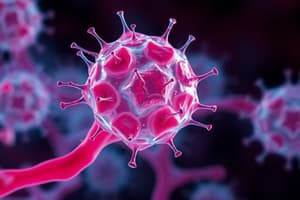Podcast
Questions and Answers
What is the function of progenitor cells?
What is the function of progenitor cells?
Progenitor cells are in transit from the stem cell state to a differentiated state, contributing to the renewal and differentiation of tissues.
Where are stem cells best found in the body?
Where are stem cells best found in the body?
In tissues with rapidly renewing cell populations such as blood cells, skin cells, and cells lining the digestive tract.
How are stem cell divisions often asymmetric?
How are stem cell divisions often asymmetric?
In asymmetric divisions, one daughter cell remains as a stem cell, while the other becomes committed to a path that leads to differentiation.
Why are stem cells often rare and difficult to identify?
Why are stem cells often rare and difficult to identify?
In what types of tissues are stem cells not readily apparent?
In what types of tissues are stem cells not readily apparent?
What are the two key features that characterize meiosis?
What are the two key features that characterize meiosis?
Where does meiosis occur in the body?
Where does meiosis occur in the body?
What is the result of the union of haploid eggs and sperm at fertilization?
What is the result of the union of haploid eggs and sperm at fertilization?
What are the two types of germ cells involved in meiosis?
What are the two types of germ cells involved in meiosis?
What are the two key structures of a chromosome during the first meiotic division?
What are the two key structures of a chromosome during the first meiotic division?
What is the role of telomerase in cancer cells?
What is the role of telomerase in cancer cells?
How do cancer cells differ from normal cells in terms of contact inhibition?
How do cancer cells differ from normal cells in terms of contact inhibition?
Explain the behavior of cancer cells in response to growth factors.
Explain the behavior of cancer cells in response to growth factors.
What is angiogenesis and how does it relate to cancer?
What is angiogenesis and how does it relate to cancer?
How do telomeres contribute to the immortality of cancer cells?
How do telomeres contribute to the immortality of cancer cells?
What is differentiation and how does it relate to cancer cells?
What is differentiation and how does it relate to cancer cells?
Describe the abnormal nuclei found in cancer cells.
Describe the abnormal nuclei found in cancer cells.
What is the main characteristic that allows cancer cells to have unlimited potential to replicate?
What is the main characteristic that allows cancer cells to have unlimited potential to replicate?
How do the characteristics of cancer cells differ from normal cells?
How do the characteristics of cancer cells differ from normal cells?
Explain how mutations contribute to the loss of control over the cell cycle in cancer cells.
Explain how mutations contribute to the loss of control over the cell cycle in cancer cells.
Study Notes
Stem Cells
- Progenitor cells function as precursors to differentiated cells, giving rise to specific cell types
- Stem cells are best found in the body's developing tissues, such as embryonic tissues, and in certain adult tissues, like bone marrow and skin
- Stem cell divisions are often asymmetric, meaning one daughter cell remains a stem cell, while the other differentiates into a specific cell type
- Stem cells are often rare and difficult to identify due to their low numbers and lack of specific markers
- Stem cells may not be readily apparent in fully differentiated tissues, like muscles and nerves
Meiosis
- Two key features of meiosis are crossing over, which increases genetic variation, and the halving of the chromosome number, resulting in haploid cells
- Meiosis occurs in the reproductive organs, specifically in the ovaries and testes
- The union of haploid eggs and sperm at fertilization results in a diploid zygote, with a complete set of chromosomes
- The two types of germ cells involved in meiosis are oocytes (egg cells) and spermatocytes (sperm cells)
- During the first meiotic division, chromosomes are characterized by their synapsed homologous pairs and the presence of a centromere
Cancer Cells
- Telomerase is key in cancer cells, as it allows them to maintain telomere length, contributing to their immortality
- Cancer cells differ from normal cells in that they lack contact inhibition, allowing them to continue growing and dividing despite physical contact
- Cancer cells behave abnormally in response to growth factors, often exhibiting uncontrolled growth and division
- Angiogenesis, the formation of new blood vessels, supports cancer cell growth and proliferation
- Telomeres contribute to the immortality of cancer cells by allowing them to maintain their telomere length, bypassing the normal process of telomere shortening
- Differentiation, the process of becoming a specific cell type, is often lost in cancer cells, allowing them to maintain their proliferative state
- Abnormal nuclei found in cancer cells include changes in size, shape, and number
- The main characteristic that allows cancer cells to have unlimited potential to replicate is their ability to bypass normal cell cycle regulation
- Cancer cells differ from normal cells in their ability to ignore normal growth and division signals, and in their ability to self-replicate and self-sustain
- Mutations contribute to the loss of control over the cell cycle in cancer cells by disrupting normal regulation, allowing for uncontrolled growth and division
Studying That Suits You
Use AI to generate personalized quizzes and flashcards to suit your learning preferences.
Description
Test your knowledge of tissue renewal and the characteristics of stem cells with this quiz. Explore the concepts of stem cell division, differentiation, and their unique microenvironment.




